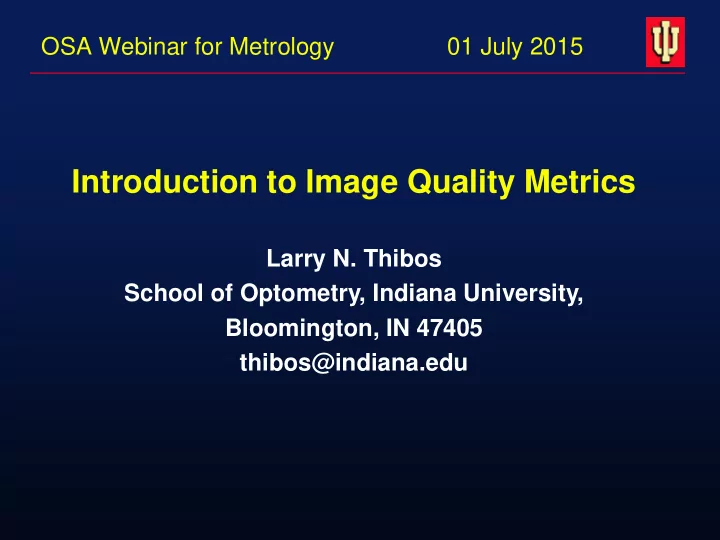

OSA Webinar for Metrology 01 July 2015 Introduction to Image Quality Metrics Larry N. Thibos School of Optometry, Indiana University, Bloomington, IN 47405 thibos@indiana.edu
Begin with a definition Key issues: How will the image be used, and for what purpose? Toraldo di Francia G. “Modern trends in the evaluation of optical images.” J Opt Soc Am . 1957;47(6):507.
Which image has better quality? Focus far Focus near
Some common uses of images Natural images record the appearance of real objects • Biological perception and action – Direct imaging of physical objects by the eye onto the retina – Indirect imaging by a man-made imaging system (e.g. a camera), which becomes a secondary object imaged by the eye • Machine vision for controlling machines (e.g robots) Artificial images render imaginary objects • Computer-to-human communication • Computer-to-computer communication
A paradigm for determining perceived visual quality Which image would you share on social media?
A method for developing a metric of image quality Image #1 Internal Imaging criterion system Object #1 Observer Image #2 decides Imaging system #2 What measure of the imaging system predicts human preferences (independent of object)?
Empirical measurement of perceived image quality Using the observer’s intuitive sense of image quality, • Observers prefer images with the largest number of perceived gray levels (JNDs, just-noticeable differences) – Granger & Cupery (1972, at Kodak, Inc. with photographic prints) – Barten (1987, at Phillips, Inc. with video displays) • Number of gray levels can be predicted from optical characteristics of the system that produced the image. => Perceptual quality can be quantified by simple measures of the MTF – SQF, subjective quality factor (Granger & Cupery, 1972) – SQRI, square root integral (Barten, 1987)
Objective prediction of perceived image quality Granger & Cupery (1972) Barten (1987) Area = Area = SQF SQRI 3 12 Nonlinear axes provide a perceptually uniform space for graphical analysis.
Limitations of perceived image quality Perceived image quality is a subjective judgment of appearance and esthetic appeal, not necessarily related to the performance of a task. Basing image quality on performance of a task takes into account the purpose of the image.
Better subjective quality may not give better performance MTF MTF
Performance image quality Equal visual performance <=> equal image quality If two images yield equal performance on a visual task, then (by definition) they have equal quality. Conversely, if two images have equal quality, then the optical systems that produced the images will enable equal performance of a task by human or machine visual systems. This generic approach to measuring image quality quantifies the imaging system that produced the images, rather than the images per se .
A performance-based method for measuring images Image #1 Object task Imaging system #1 Observer Image #2 Imaging system #2 Equal performance => equal image What measure of quality these filters reveals their equality?
Specifying optical filters Point-spread Function Wavefront aberration map (pupil plane) Optical Transfer Function
In what way are these two imaging systems the same? 0 = +0.6 , C 4 0 = +0.1 C 2 Filter #1 0 = -0.3 , C 4 0 = +0.1 C 2 Filter #2
Spatial metrics of PSF quality* Narrow, compact PSF => quality optics. *R. Bracewell “The Fourier Transform and Its Applications” McGraw-Hill; 1978.
Image Quality Metrics for Point Objects Compact, high-contrast point image => quality optics. Spatial Compactness Point image 1. Area catching 50% light 2. Equivalent width 3. Second moment 4. Half-width at half-height Hi-Q 5. Correlation width Image Contrast 1. Strehl ratio 2. Light in diffraction core Low-Q 3. StdDev of light intensity 4. Entropy
Image Quality Metrics for Grating Objects High contrast image w/o phase shifts => quality optics. 1. Cutoff frequency, rMTF Grating image 2. Area between rMTF, visual thresh 3. Cutoff frequency, rOTF Hi-Q 4. Area between rOTF, visual thresh 5. Strehl ratio (OTF) 6. Strehl ratio (MTF) 7. OTF volume/ MTF volume Low-Q
Taking the image consumer into account Including characteristics of the image consumer (human or machine) in metric calculations emphasizes image components that are most useful for task performance. For example, modifying the definition of Strehl Ratio by weighting the OTF by the observer’s contrast sensitivity function de- emphasizes the less visible components of an image.
Visual Strehl Ratio: a measure of visual quality Optical Visual Visual PSF weight PSF Compare peak of = visual PSF to ideal case Visual Optical Compare Visual sensitivity OTF volume of OTF visual OTF = X to ideal case
Bibliography Bracewell RN. The Fourier Transform and Its Applications. second ed. New York: McGraw-Hill; 1978. Wetherell WB. The calculation of image quality. In: Shannon RR, Wyant JC, editors. Applied Optics and Optical Engineering. New York: Academic Press; 1980. p. 172-315. Shannon RR. The Art and Science of Optical Design. Cambridge: Cambridge University Press; 1997. (chapter 4) Martens JB. Multidimensional modeling of image quality. Proc IEEE. 2002;90(1):133-53. Thibos LN, Hong X, Bradley A, Applegate RA. Accuracy and precision of objective refraction from wavefront aberrations. Journal of Vision. 2004;4(4):329-51. (Appendix defines 31 metrics)
The end Vision Research at http://www.opt.indiana.edu
Recommend
More recommend